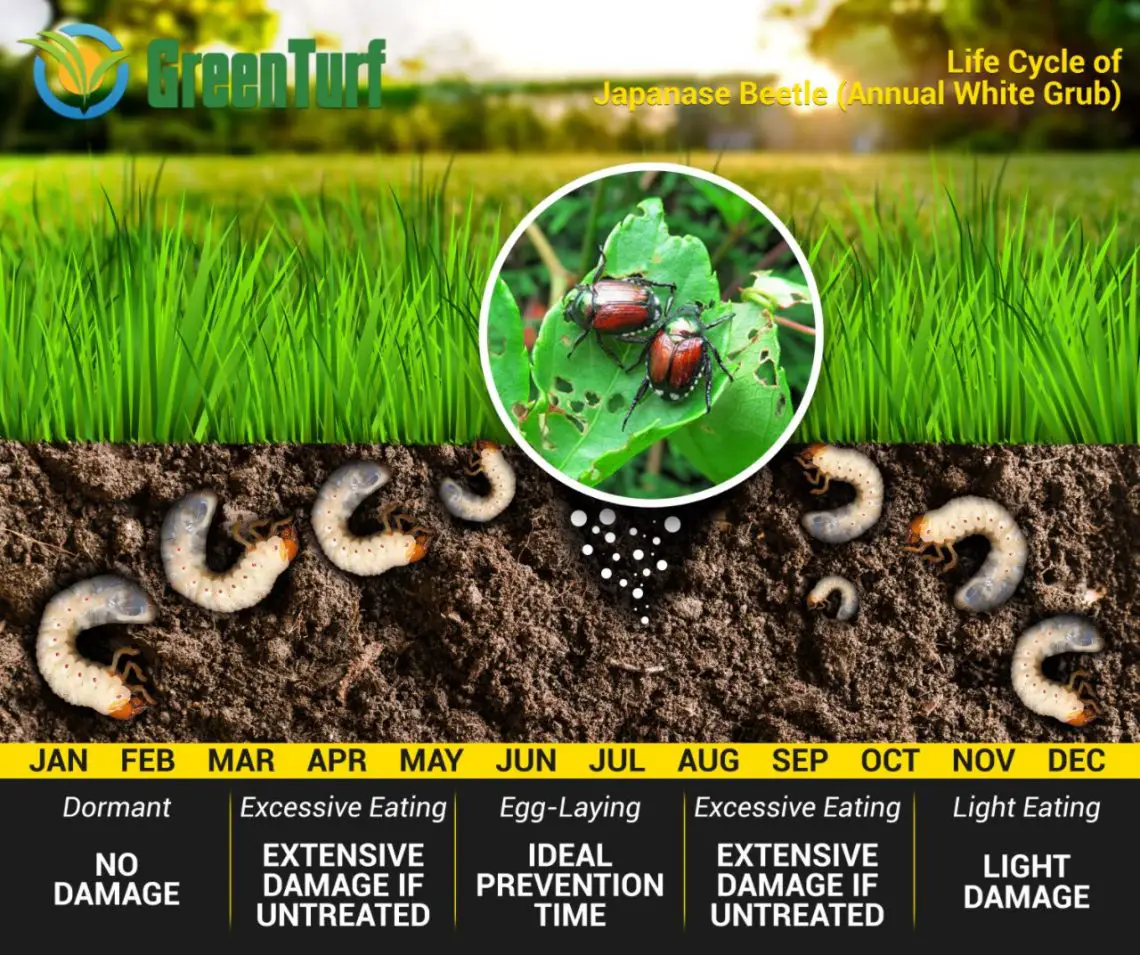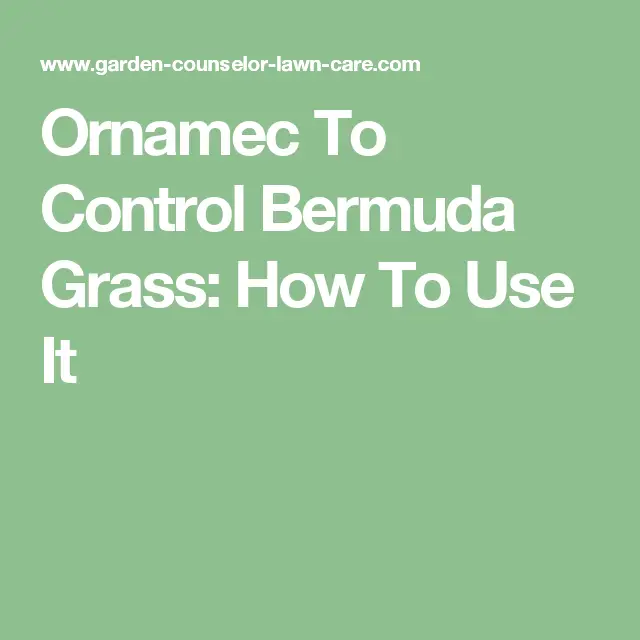Use Neem Oil Or Azadirachtin
Azadirachtin is a component of neem oil. While many people think neem oil and Azadirachtin are the same things, neem oil contains very little Azadirachtin.
As such, people usually buy concentrated Azadirachtin to use on their lawns. According to one study, Azadirachtin application on Kentucky bluegrass killed Japanese beetles at 5x the products label rate.
Neem oil is another pest control option. Pure neem oil deters the grubs from feeding, growing, and laying eggs. For best results, mix neem oil with water and spray the diluted solution on affected areas.
Pros: Both options are affordable Azadirachtin is classified by the EPA as relatively non-toxic , while neem oil is considered non-toxic, which means it wont harm people or non-target organisms.
Cons: Both neem oil and Azadirachtin require regular reapplication despite its efficacy at killing larval Japanese beetles, Azadirachtin wont kill mature beetles or deter them from laying eggs.
Lawn Grubs: What They Look Like
- White grubs are similar in appearance but may differ in size.
- Size varies with the species, but when fully developed, they can range from 3/8 inch to nearly 2 inches in length.
- Grubs are cream-colored with a brown head. They have three pairs of short legs.
- Soft bodies that are usually curled into a C shape.
- Adult beetles are oval in shape. They can be green, tan, brown, or black and can range from 3/16 of an inch to 1 inch in length.
- Most species arent noticed because they are active at night. Often they are seen only when attracted to outdoor lights.
Knowing When To Take Action
Remember, seeing a few grub worms in your soil is no cause for concern. Unless your lawn develops brown patches that easily peel back or you spy 15 or more grubs per square foot of lawn, just ignore them. Theyre a great food source for birds, salamanders, ground beetles, toads, frogs, and other creatures.
For more on caring for your landscape organically, please visit the following articles:
You May Like: When To Fertilize Lawn In South Carolina
The When Of Grub Worm Treatment
Grubex from Scotts is effective and a long lasting pest control but like diazinon Grubex can take 3 weeks to kill the grub wroms under many conditions. Scotts recommends applying Spring to Late Summer before insects hatch to prevent turf grass damage.
The best time to apply is probably around July once you know the numbers of adult grubs are high, soil moisture is low to keep the beetles egg laying concentrated.
How To Get Rid Of Grub Worms In Lawns

When grubs crash your lawn party, its a serious problem. As your lawn begins to green up in early spring, dead patches are usually a dead giveaway that these uninvited pests are lurking. Patches of grass that appear brown and lackluster can be a sign of various lawn pests, but a grub infestation is easy enough to diagnose â and treat.
Also Check: How To Properly Reseed Your Lawn
Do Grubs Turn Into Cicadas
Technically they’re called nymphs, not larvae. When cicadas progress from one stage of development to another, they molt, rather than pupate. … When the eggs hatch, the cicadas don’t look like a grub or maggot as you might expect instead they look like tiny termites or ants, with 6 legs and antennae.
How To Control Armyworms In The Lawn
These militant moth larvae can really chow down on your grass if you dont fight back.
Aggressive little grass-eaters, armyworms will help themselves to your lawn if not stopped in their tracks. Patches of brown turf and chewed-up blades are a call for helpyour grass needs saving and its time to take action. Heres the lowdown on these tiny tyrants, plus how to kill armyworms and get your grass growing again if theyve tried to conquer your lawn.
Dont Miss: What Is The Best Cordless Lawn Edger
Read Also: How To Eliminate Clover In My Lawn
When To Treat For Grubs In Central Texas
Grubs are a common lawn pest in Central Texas that can really do a number on your lawn. They eat grass, causing unsightly brown patches. Grubs are the larval form of a beetle and may not be able to fly but they can run over 4 mph, which is pretty fast for a worm. They can be treated using insecticides but it is best to just avoid being infested in the first place.
Since grubs are the larval stage of a beetle it is important to identify the grub as well as the beetle so you can treat for both pests at once. Knowing what type of grub you have and when they will start to cause lawn damage will help you prevent an infestation from happening in the first place.
The most common type of grub found in Central Texas is one that has a brown body with yellow stripes on its sides. These little caterpillar-like larvae crawl around leaving brown streaks behind, often making a grub trail. The adult form of this pest looks more like a fly than a worm and tends to eat mostly dead plant matter such as leaves. You may notice them floating over your lawn or flying around the yard in groups in the late spring, early summer. The adult form of this grub is a June beetle and looks like a typical flying beetle with antennae, two pairs of wings, thick legs, and a noticeable yellow stripe down its back.
Warning
Grubs, which live under the soils surface and eat grasses roots, can harm a lawn. When a grub infestation grows out of control, you may see patches of dead or dying grass in your yard.
How To Treat Lawn Grub Infestations
- Timing – The best time to treat your lawn and get rid of this common garden pest is in spring, when the grubs are newly hatched. Grubs can also start appearing in the early autumn, so if you have treated your lawn in spring, its a good idea to re-treat it in the autumn to properly break this cycle.
- Moisture Eggs hatch in moist conditions, so water your lawn well for a week or two before you treat it. This will make sure that the eggs are hatched when the pesticide is applied.
- Water in To get your natural or chemical pesticide into the soil and to the grubs, water your treatment in so that it soaks into the first 10cm of the soil. Do not apply it before heavy rains, as this may wash it away.
- Chat to your neighbours These pests spread and migrate quite quickly, so its a good idea to chat to your neighbours about keeping an eye on their lawns.If a bordering garden has an infestation, it will keep spreading to your lawn while it remains untreated.
- Go natural Wherever possible, try to use a natural, eco-friendly lawn grub treatment. This will limit the damage a pesticide can do to beneficial insects, the water table, and the local ecosystem.
Also Check: How To Level Out Your Lawn
Will Soapy Water Kill Lawn Grubs
There are several commercial killers available to kill grubs in your lawn, but you can also use a homemade recipe with dish soap to kill the grubs. When sprayed, Dawn dish soap smothers the grubs until they die. The grubs once in contact with the soapy solution suffocate and die within a few minutes.
What About Preventive Chemicals For Grubs
Preventative measures for grub control work with curative methods to keep these destructive insects away.
Preventive methods contain chemicals like thiamethoxam, imidacloprid, or clothianidin and help lower the grub population on your lawn by 75% to 100% when applied in July or June.
You must also irrigate the yard with a minimum of 0.5 inches of water immediately after applying the chemicals.
You May Like: How Much Lawn Mowing Cost
These Insatiable Pests Munch Your Grass Leaving Unsightly Bald Patches Heres How To Spot Them And Eliminate Them
A nuisance to homeowners and farmers, cutworms feed not only on lawns, but also on vegetable plants, ornamentals and farm crops. Found across the globe, they are known to cause significant damage once theyve taken up residence.
These non-discriminate feeders attack a wide range of plants, says lawn expert Dave Holmes of The Grounds Guys. All common turfgrasses are susceptible to damage by the larvae that feed at night. Heres how to spot these ravenous pests and send them packing before they cut your yard to shreds.
On This Page
Recommended Reading: How Much Does Trugreen Cost Per Year
Applying A Beetle Grub Treatment

Fertilization can help you prevent the problem while poisoning is a measure for the times when you realize that the grub eggs have already been laid down.
There are certain garden chemicals and grub control products that contain potent but to humans not really dangerous chemicals and ingredients, like imidacloprid, trichlorfon, or halofenozide.
Merit insecticide is a product like that, and it will poison the grubs when they hatch. Make sure to educate yourself about the product though, as some can affect the birds that would eat the grubs.
Penn State University also suggests using organic neem oil pesticideAnother alternative is neem oil, a botanical pesticide. Extracted from the tropical neem tree, neem oil contains insecticidal properties and can act as a repellent, deterring feeding, insect growth and egg laying. Mix the neem oil with water as directed on the label and spray the diluted solution generously on affected areas.
More on Using Neem Oil for Controlling Lawn Grubs
Also Check: How To Measure Lawn Size
Preventing Worms In Grass Is The First Step
Perhaps the best way to keep pests away from a lawn is proper maintenance and keeping it healthy. To do this, plant a variety of plants to avoid a monoculture , which can draw higher amounts of a certain kind of pest. Also, pick plant species that are less prone to pests and diseases. This is called cultural prevention.
Whenever possible, improve soil, nutrient and moisture for the plants to ensure they are as healthy as possible and thus more resistant to diseases and pests. Attempt to choose plants best suited to the climate and use good planting techniques for each plant and the grass.
Recommended Reading: Putting Lime On Your Lawn
Do Grubs Eat New Grass Seed
Identifying and Treating Infestations Grubs in new sod are of particular concern and should be treated right away. Inspecting your lawn in the spring and catching a grub infestation early is the best way to avoid extensive damage to your lawn and to prevent a later infestation of fully grown beetles.
Don’t Miss: When Should I Treat My Lawn For Grubs
How To Get Rid Of Grubs In Grass
Dealing with a grub problem usually means using a pesticide. A preventive application in the spring will kill the grubs that have already hatched and keep new ones from hatching throughout the season.
Because preventive pesticides are typically combined with fertiliser, its important to apply them in the spring, so they dont burn the grass. Watering is also important, to ensure that the pesticide reaches deep into the soil where the grubs are hiding.
A curative application is in order if you discover a widespread grub problem. These pesticides will kill the larvae on contact, but dont work for as long. Its usually best to call a professional for curative pesticides.
Watering your lawn appropriately can help in grub control. Grubs love moisture and tend to die out in drought conditions so watering your lawn infrequently but deeply can help keep grubs away by preventing the soil from being too moist.
Keep an eye on how your neighbours lawns look as well. Grubs are rarely limited to one yard, so if you see signs in your neighbourhood, its likely you have the pesky critters as well.
Signs Of Grub Worms In Lawn
A lawn thats developing brown patches and showing signs of weakening could be suffering from disease. Fungal infections commonly produce brown spots, but even white grubs in your lawn can cause similar signs.
Here are signs of grubs in your lawn and how to check for these destructive worms:
- Dead patches in the lawn: Youll observe patches of brown or dead spots as the grass starts to thin out, turn yellow, and die. This occurs because grubs feed on roots, thus killing your turfgrass easily. Check out this great article I did on other causes of brown patches in lawns.
- A spongy turf: Grubs will damage the roots of turfgrass, leaving the grass easy to pull and roll up just like carpet. To test this symptom, you can do a tug test on your grass to see if it pulls up too easily.
- Increased raccoon and bird activity: Birds, moles, and raccoons feed on worms and other insects in the lawn. If you notice theres increased activity of these predators digging your lawn, it could be a sign there are grubs in your lawn.
- Presence of many grubs in the soil: A major sign of grub infestation in your lawn is the presence of the milky-white, C-shaped worms in soil samples cut from your yard. A few of these pests shouldnt stress your grass, but a large number of them can cause serious damage. More than 5 grubs per square foot of lawn soil will produce symptoms of white grub damage.
Read Also: What Is Lawn Aeration Do
Use Azadirachtin Or Neem Oil
Azadirachtin and Neem Oil are usually considered the same thing, but that is not true. On the contrary, Azadirachtin is a substance in neem oil.
You can buy concentrated Azadirachtin to kill grubs or neem oil in pure form to discourage these insects from laying eggs, feeding, and growing.
Mix water and neem oil, then spray the solution on your lawn.
When To Call Pest Control Pros
If in doing the tally, you find more than six grubs per square foot, its a good time to take action. Dont wait until you have a serious infestation.
I always chuckle about , in that skunks and raccoons havent read about this threshold, says Shetlar. If there are four to five grubs per square foot, thats usually enough for them to be digging around.
It might also be enough for you to call in your local pest control professionals to avoid further damage to your lawn.
Recommended Reading: How Long Does It Take For Lawn Fertilizer To Work
How Do Grubs Damage Your Lawn
The extent of damage caused by grubs on your lawn depends on how big the population of these insects are in your yard.
While a tiny population of, say, below five grubs per square foot will not damage your grass, over ten grubs per square foot will lead to severe damage.
Grubs diet consists mainly of the roots of grass and organic matter found in the soil. So as these insects consume the grass roots in your lawn, they damage them, depriving your grass of soil nutrients and water. This makes the grass in your yard brown, patchy, and dead.
A large grub population on your property will also attract creatures that eat these insects, like ground moles, raccoons and birds, which will tear up and destroy your lawn to find the grubs.
What Are White Grubs

Although there are many different types of lawn grubs, white grubs in particular refer to the larvae of Japanese beetles. These pests lay eggs in moist soil during the spring and grow to maturity by late summer. Once they have reached adulthood, they will begin to feed on leaves, fruits, and vegetables around the lawn.
A few grubs are not likely to cause problems in your lawn, but a larger grub population will make short work of your garden, landscape, and grasses.
Read Also: How Much To Mow My Lawn
When To Treat For Grubs In Central Texas:
The best time of year to use grub control is as soon as you notice the lawn being eaten by a grub problem. A systemic insecticide will work its way through the grass blades and down towards the roots, protecting your grass from larval beetles and larvae that are feeding on the roots of your yard. It is very important to read the labels on the grub control products before using them so you fully understand how to properly apply it. Some require watering in after application while others should not be watered directly afterward.
Once you have treated your yard for grubs it is time to eliminate them from your lawn and prevent any future grub damage. The adult beetles tend to be attracted to light, which makes them a lot easier to catch once they are flying around in the late spring and summer months. You can use a beetle trap or just turn on the backyard lights at night when you see these bugs flying around looking for mates. You should continue turning on the lights until all of the June beetles have found a mate or died off for the season. This will keep June beetles from mating and laying eggs in your yard, causing an infestation next year too. Also mowing regularly tends to deter June beetles from entering your yard, so keep that in mind when planning your mowing schedule.
Read Also: How Often Should You Water Your Lawn In Utah
Scotts Grubex1 Grub Killer For Lawns
With one application in spring, you can treat your lawn and prevent grubs for up to 4 months, providing full coverage through the season.
Annual use will help keep Japanese beetles under control, and help protect your flowers and vegetable garden crops. It will also kill armyworms, chinch bugs, cranefly larvae, and billbug larvae.
Don’t Miss: How Much Do You Pay For Lawn Care